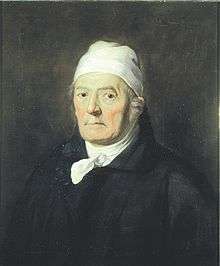Nikolaus Simrock

Nikolaus Simrock (23 August 1751 in Mainz – 12 June 1832 in Bonn) was a German horn player at the court of the Elector of Cologne in Bonn and a music publisher. He was a friend of Ludwig van Beethoven and founder of the N. Simrock music publishing house.[1] "Highly esteemed as a man and a musician", he remained in contact with Beethoven throughout the 1790s and is a regarded as a "reliable witness" to Beethoven's years in Bonn.[2][3]
Biography
Simrock was born in Mainz the son of a corporal and was a horn player in a French military chapel before age 16. He applied at the Cologne Elector Maximilian Frederick for a job in the Bonn court orchestra. He began working there in April 1775 as "bugler" with an annual salary of 300 florins. The young Beethoven later played in the same orchestra.[4]
Simrock was one of the most famous philosophers of the Enlightenment in the elector's residence. Like his colleagues Franz Anton Ries and Christian Gottlob Neefe, he belonged to the Minervalkirche Stagira, an association of the Order of Illuminati. After its demise he was a founding member of the "Lesegesellschaft" (Reading Society) in Bonn. He was a member of the Masonic Lodge "Les Frères courageux", founded in Bonn in 1805.[5][6]
In 1793, Nikolaus Simrock founded the music publishing house N. Simrock in Bonn. Two of his early publications were Beethoven's variations "Das rote Käppchen" (WoO 66) in 1793 and variations on a theme by Waldstein (WoO 67) in 1794.[2] One reason for the success of this company – in addition to Simrock's business acumen – was his pro-French attitude that paid off after the electoral period in 1794 during the early occupation of Bonn and the Rhineland by French revolutionary troops.
Simrock had become one of the most important European music publishers by the beginning of the 19th century. Under his leadership, N. Simrock published first editions of music by Joseph Haydn,[7] whom he met in person,[4] and Ludwig van Beethoven (13 first editions).[1][4]
Among the notable composers published after Simrock's death were Robert Schumann, including his Third Symphony[4] and Felix Mendelssohn, including his oratorios Elias and Paulus.[4][8] Fritz Simrock, his grandson, moved the headquarters of the publishing house from Bonn to Berlin in 1870. He is especially known for publishing works of Johannes Brahms.[9]
Personal life
Simrock was married to Franziska Ottilie Blaschek from Mainz and they had 13 children together.[10] The family members influenced nearly 200 years of cultural history of the Rhineland. One of his sons, Peter Joseph Simrock, ran the publishing business, another son was for many years the manager of the Hotel "Trierer Hof" in the market square, where Alexandre Dumas was a guest.[11] The youngest son, Karl, was an editor of old and middle German literature and German literature of the 19th century.[11]
References
- 1 2 Cooper, Barry (8 October 2008). Beethoven. Oxford University Press. p. 3. ISBN 978-0-19-531331-4. Retrieved 23 April 2012.
- 1 2 Thayer, Alexander Wheelock; Forbes, Elliot; Krehbiel, Henry Edward (23 March 1992). Thayer's Life of Beethoven. Princeton University Press. p. 169. ISBN 978-0-691-02717-3. Retrieved 23 April 2012.
- ↑ Senner, Wayne M. (1 September 1999). The Critical Reception of Beethoven's Compositions by His German Contemporaries. U of Nebraska Press. p. 108. ISBN 978-0-8032-1250-3. Retrieved 23 April 2012.
- 1 2 3 4 5 "Nikolaus Simrock" (in German). Stadtmuseum Bonn. 2012. Retrieved 1 May 2012.
- ↑ Deutsches Historisches Institut (Paris, France) (1992). Francia: Revolution, empire, 1500–1815 : Forschungen zur westeuropäischen Geschichte. Frühe Neuzeit. Thorbecke. p. 140. Retrieved 23 April 2012.
- ↑ Alain Maureau; Germaine Peyron-Montagnon; André Palluel-Guillard (1978). Grands notables du Premier Empire: notices de biographie sociale. Centre national de la recherche scientifique. p. 107. ISBN 978-2-222-02280-0. Retrieved 23 April 2012.
- ↑ Stevenson, Robert Murrell (1981). Inter-American music review. R. Stevenson. p. 19. Retrieved 23 April 2012.
- ↑ Mercer-Taylor, Peter Jameson (21 October 2004). The Cambridge Companion to Mendelssohn. Cambridge Companions to Music. Cambridge University Press. p. 289. ISBN 978-0-521-53342-3. Retrieved 23 April 2012.
- ↑ American Brahms Society (1 December 1998). Brahms Studies. U of Nebraska Press. p. 5. ISBN 978-0-8032-1287-9. Retrieved 23 April 2012.
- ↑ Wenig, Otto (1968). Buchdruck und Buchhandel in Bonn. Röhrscheid. p. 121. Retrieved 23 April 2012.
- 1 2 Simrock, Karl Joseph; Pinkwart, Doris (1979). Karl Simrock. Universitätsbibliothek Bonn, Röhrscheid. pp. 37–41. ISBN 978-3-7928-0416-2. Retrieved 23 April 2012.